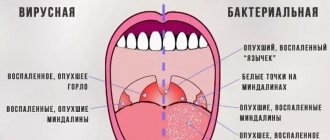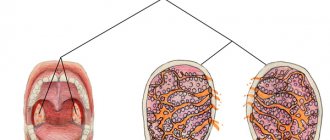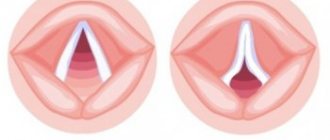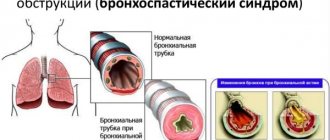What is chronic tonsillitis
Chronic tonsillitis is defined as an infectious inflammation of the palatine tonsils, characterized by enlargement, swelling, and redness of the lymphoid tissue. Often purulent contents are observed in the lacunae of the tonsils. Tonsillitis is considered chronic when tonsillitis (acute tonsillitis) occurs in a child more often than 2 times a year.
The palatine tonsils are organs of the immune system that belong to the lymphoid pharyngeal ring. They are the first to encounter an infection that has entered the oropharynx. Immediately after contact with an infectious agent, the tonsils begin to produce immune cells and destroy viruses or bacteria. At the same time, a signal is transmitted to all other organs of the immune system about an infectious attack of the body, and all organs and tissues go into a state of “combat readiness.” While fighting an infection, the tonsils increase in size, swell, and turn red. All this suggests that an inflammatory, one might say defensive, process is taking place in them, the purpose of which is not to allow the infection to pass further into the respiratory tract.
After two cases of sore throat in a year, tonsillitis can become chronic.
Forms of the disease
There are three forms of chronic tonsillitis depending on the severity:
- Compensated chronic tonsillitis . With this form of the disease, local symptoms (enlargement, redness of the tonsils) prevail over the general ones (fever, weakness). The general condition of the child is disturbed only during exacerbation of the disease.
- Subcompensated form of chronic tonsillitis . Local symptoms (loose, swollen tonsils, purulent contents in the lacunae) are very pronounced. And general symptoms (fever, joint pain, changes in blood pressure, general weakness) are moderate.
- Decompensated chronic tonsillitis . Against the background of pronounced local symptoms, a disturbance in the general condition of the body is observed. Diseases associated with chronic tonsillitis (rheumatic fever, glomerulonephritis, arthritis, vasculitis) or serious complications (peritonsillar abscess, chronic lymphadenitis) occur.
At-risk groups
- Carriers of pathogenic microflora. These are those children on whose mucous membranes pathogenic microorganisms live. Under favorable conditions (hypothermia, decreased immunity), they cause an exacerbation of the disease. The presence or absence of pathogenic bacteria can be determined using bacteriological examination - culture of the oral mucosa for microflora. One of the most common pathogens that causes sore throats is group A beta-hemolytic streptococcus.
- Children with low body weight, accustomed to an unbalanced diet. Insufficient consumption of protein foods and vitamins will lead to a decrease in the body's defenses (immunity).
- Children with congenital or acquired immunodeficiency conditions. A lack of immune cells leads to frequent sore throats.
- Children exposed to frequent hypothermia. Low temperatures are stressful for the body; in such conditions, the immune system begins to work in a perverted mode (a small amount of bacteria or viruses can cause the development of the disease).
- Carriers of chronic infection. Untreated caries, stomatitis, sinusitis (sinusitis, frontal sinusitis) create a chronic infectious focus, which at any time can lead to tonsillitis (tonsillitis).
- Children with allergic reactions.
Any allergy is a manifestation of the active functioning of the immune system. When the body is in a state of allergic mood, that is, the cells are always ready for an immune response, then even the slightest amount of bacteria getting on the tonsils leads to an outbreak of tonsillitis.
Causes of the disease
The lymphoid tissue that makes up the tonsils is part of the body's immune system. Its main function is to fight infection that enters the human throat. If the body is weakened, it is unable to produce sufficient quantities of lymphocytes and interferons. Pathogenic pathogens win and the inflammatory process begins to develop.
The compensated form of chronic tonsillitis is characterized by the fact that the immune system still contains the infection, but is not able to defeat it completely. Any weakening of the body, even slight hypothermia, provokes an exacerbation of the disease.
In most cases, the pathology develops after an acute inflammatory process. The main causes of compensated chronic tonsillitis include:
- sinusitis and sinusitis;
- depression, psycho-emotional stress;
- gingivitis, caries;
- unfavorable living conditions;
- pathologies of the structure of the nasal passages;
- tuberculosis processes;
- measles, scarlet fever;
- unhealthy diet (abuse of sweet and starchy foods, fast food, sweet carbonated drinks, lack of minerals and vitamins);
- prolonged hypothermia;
- bad habits (drinking alcohol, smoking);
- heredity.
The compensated form of chronic tonsillitis can persist in the patient for years. Gradually, without adequate treatment, lymphoid tissue begins to be replaced by connective tissue. This leads to narrowing of the gaps and the accumulation of food debris, dead leukocytes and bacteria, and toxins. Some of this purulent content enters the blood and poisons the body.
Causes and symptoms
Chronic tonsillitis is a multi-cause disease. In the first place among the causes is a bacterial infection (streptococci, staphylococci). Less commonly, recurring sore throats are caused by a viral infection (adenovirus).
Considering the unreasonably high frequency of use of antibiotics in the treatment of any “sore throat”, fungal infection (candida) also plays a fairly large role in the occurrence of chronic forms of tonsillitis.
Chronic forms of inflammation of the tonsils can occur in the form of recurring sore throats or as a sluggish process without acute tonsillitis (tonsillitis). This is the so-called nonanginal form.
The period of exacerbation of chronic tonsillitis (angina) is characterized by local and general manifestations. Local symptoms include:
- increase in the size of the palatine tonsils;
- hyperemia (redness), swelling of the palatine tonsils and their fusion with the palatine arches;
- liquid pus or hard purulent plugs in the lacunae of the tonsils;
- enlargement of the submandibular or anterior cervical lymph nodes and pain when palpating them.
Photo gallery: external manifestations of chronic tonsillitis
The tonsils of a child with chronic tonsillitis are enlarged in size
In the lacunae of the tonsils with chronic tonsillitis, purulent contents are often visible
Tonsils are swollen and hyperemic
Common symptoms include:
- elevated body temperature, usually subfebrile (up to 38 degrees);
- a sore throat;
- manifestations of general intoxication of the body (lethargy, weakness, loss of appetite, nausea, fatigue);
- joint pain;
- disturbance of cardiac activity (increased heart rate, instability of blood pressure, sometimes pain in the heart of a functional nature).
In the periods between exacerbations of chronic tonsillitis, the child, as a rule, remains with problems such as general weakness and fatigue. After a short game he needs to rest.
Low-grade body temperature (37.0–37.3 degrees) may persist for a long time - a sign of sluggish chronic inflammation in the body. There is also a constant bad breath and a slight sore throat, which can sometimes radiate to the ear.
Chronic decompensated tonsillitis: what are the symptoms, necessary treatment
It often happens that after a serious illness there are unpleasant consequences that cannot be ignored. Tonsilitis belongs to this type of dangerous disease. This inflammatory process affects the tonsils of the throat and palate and is long-lasting and serious. Both adults and children are sensitive to it (it is least pronounced in infants).
Tonsillitis occurs after diseases associated with inflammation of the mucous membranes. These include
: :
- measles;
- scarlet fever;
- diphtheria;
- severe forms of angina.
It has a number of features and has two types of treatment - conservative and surgical, depending on the form. Tonsillitis is a focal disease, i.e. the acute manifestation is inflammatory, so all medical procedures are aimed at destroying the “core” of the infection and subsequent relief of symptoms.
Tonsillitis has two forms :
Acute tonsillitis is caused directly by a disease, most often angina. Chronic tonsillitis is more dangerous. This occurs when the first form is not completely cured and the person has “smoldering” foci of the disease. Any infection or hypothermia restarts the disease mechanism, and tonsillitis can not only develop again, but also lead to serious complications.
Chronic tonsillitis continues to develop. It can be compensated or decompensated. The first option is unlikely to interfere with human health, except that it is the starting point for the development of the disease.
Decompensated chronic tonsillitis occurs in the surviving focus. This increases the risk of angina and often leads to inflammation of not only the tonsils, but also the ears and sinuses.
This is the focus of most doctors.
Causes
- Chronic tonsillitis is caused by the following processes :
- - Bacterial infections - weakened immunity - angina pectoris with frequent episodes;
- - frequent use of antibiotics that slow down the immune system.
Symptoms of chronic tonsillitis
We distinguish between chronic tonsillitis in adults and children.
In the first case, tonsillitis occurs in a milder form, so its symptoms are often ignored until medical intervention is required. It begins with acute pain, which is especially noticeable when swallowing. Over time, the discomfort intensifies and the pain returns to the ear.
Gradually swelling of the throat and larynx occurs and eating becomes more difficult until a stage is reached where it is impossible to eat even thin soups.
The danger of tonsillitis in adults is expressed in the fact that the disease develops gradually at the beginning: the temperature rises slightly, only up to 37 degrees, mild poisoning, weakness, which is easily confused with fatigue, some tinnitus, and rarely negative pressure.
Only a doctor with extensive experience in his field is able to correct such various deviations from the norm, bring them into the overall picture and make the correct diagnosis. If the conclusion is made late, then there is no hope for conservative treatment.
In children, however, chronic decompression tonsillitis is more severe. By evening, the temperature will certainly rise, and a sensation in the throat will appear quite quickly, preventing swallowing and swelling.
Poisoning expresses itself much more clearly, causing severe weakness and sweating, and a burning sensation occurs around the almonds. The child may have difficulty swallowing, and coughing may cause pus-filled bumps.
If you do not see a doctor on time, you can expect heart complications: chest pain, lack of oxygen, rapid heartbeat.
Treatment of chronic tonsillitis
There are two methods of treating chronic tonsillitis. If the doctor noticed the symptoms in a timely manner and made a diagnosis, then conservative treatment is also possible. It takes place in several stages, which are combined and intertwined.
The first step is to administer a course of antibiotics to the sick child or adult. When choosing a course of antibiotics, doctors are guided by the type of bacteria that caused the disease.
In most cases, penicillin-based drugs are prescribed - they not only act on the disease, but are also a good prophylactic for a weakened body. Pure penicillin is a thing of the past, and its dosage was replaced by semi-synthetic drugs: Amoxicillin, Flemoxin.
We should not forget that antibiotics are used only in cases of acute chronic tonsillitis, and not for the prevention of the disease.
The next step is to strengthen the immune system so that the body can once again fight stress and disease. To do this, choose products based on plant components such as chamomile, propolis and echinocea.
Polyoxidonium is often prescribed - this medication has properties that stimulate the immune system and reduce poisoning in the body.
Used to increase the production of antibodies, which help the body fight infection.
Physiotherapy
Physiotherapy is used for active measures in the heart area. The patient is prescribed inhalation and ultraviolet radiation. There are also a number of activities related to cleaning the tonsils - they are washed with an antibiotic solution and cleared of pus using fucillin or sanguirritin.
For complex treatment, rinsing is also used. A solution of Lugol, Fucilin, Miramisin and Hexoral, suitable for medications. They are easily diluted at home. Dosage - a teaspoon or 40 drops, Fucilin - one or two tablets per glass.
When chronic tonsillitis has entered the acute stage, you need to resort to surgical intervention. For small tonsils, laser treatment or bloodless removal using cryosurgery can be performed. The operation is performed under local anesthesia.
Consequences of surgery - how serious are they?
This topic occupies many people, but it can be said that the harmful effects are sometimes exaggerated. Of course, the tonsils are a barrier to infections that try to enter the body. But this barrier is one of many. If you take care of your health, don't overuse antibiotics, and take classes to strengthen your immune system from time to time, you can protect yourself well.
Prevention of chronic tonsillitis
In order not to expose the body to the risk of deterministic tonsillitis, it is necessary to constantly strengthen the immune system. You can take a contrast shower or test the shower - the main thing is not to overdo it, lowering the water temperature so as not to catch tonsillitis and colds.
It would be good to drink tea from a herbal complex in the kitchen: it may not taste as good as usual, but it will greatly help the body. The pharmacy has a wide range of vitamins for your needs. They can be taken as a fixed medicine and daily.
It is very important to be careful not to overheat or get too cold. Always dress according to the weather; in cloudy weather, take an umbrella with you, and in winter, be sure to wear a scarf and a high collar.
15
Traditional treatment
Is it possible to get rid of chronic tonsillitis forever? In medicine, there are cases where stable remission (absence of symptoms) of this disease was achieved. But for this it is necessary to persistently and systematically observe preventive measures, correctly and quickly relieve exacerbations of chronic tonsillitis. If your baby experiences the first symptoms of a sore throat, you should not self-medicate; it is better to immediately contact your doctor.
It is important to know that before starting complex conservative treatment, it is recommended to sanitize (disinfect) foci of infection in the body - cure caries, chronic sinusitis, adenoiditis, chronic rhinitis.
Conservative treatment regimen
The treatment regimen for chronic tonsillitis without surgery includes the following points:
- Elimination of the cause of the disease (antibacterial or antiviral therapy). Used only in the treatment of subcompensated or decompensated forms.
- Local treatment. Gargling with antiseptics, rinsing tonsil lacunae.
- Immunostimulating therapy (echinacea preparations, aloe).
- Removing intoxication with antiallergic drugs.
- Physiotherapy (UV or ultraviolet irradiation, ultrasound, laser irradiation, electrophoresis, mud applications).
- The use of antipyretic drugs when body temperature rises above 38.5 degrees.
Table: drugs for the treatment of chronic tonsillitis
| Item no. | Group of drugs | Drug name | Indications for use, for what purpose they are prescribed | Contraindications | Age groups (at what age is it allowed), how long to take |
| 1 | Antibacterial drugs (group of aminopenicillins, cephalosporins or macrolides) | amoxicillin (Flemoxin, Gramox, Amoxil), Amoxiclav (Augmentin, Flemoklav) | Subcompensated and decompensated form of chronic tonsillitis | Allergy to amoxicillin, infectious mononucleosis | From birth, take for at least 5 days |
| cefuroxime (Zinnat) | Newborns and premature babies | From 1 month, take 5–7 days | |||
| azithromycin (Sumamed) | Macrolide intolerance, children weighing less than 10 kg | Children weighing more than 10 kg, take 3–5 days | |||
| 2 | Antiviral drugs | Amiksin | Drugs are prescribed if an exacerbation of chronic tonsillitis is suspected to be of a viral nature. | Children under 7 years old | From 7 years old, take 3–6 days |
| Isoprinosine | Contraindicated in patients with kidney disease, as well as in case of individual intolerance to the drug. | Children weighing more than 10 kg, take 5–7 days | |||
| 3 | Immunostimulating drugs | Echinacea preparations (Echinacea ratiopharm tablets) | Prescribed to stimulate the child’s immune system | Children under 6 years old, allergic reaction to echinacea | From 6 years old, take no more than 14 days |
| Aloe extract injectable | Children under 1 month | From 1 month, course 15–50 days | |||
| 4 | Antihistamines (anti-allergic drugs) | Levocetirizine preparations (Zodak, L-cet), desloratadine preparations (Erius) | Used for decongestant and desensitizing purposes | Children under 6 months | From 6 months, course no more than 10 days |
| 5 | Local antiseptics | Chlorophyllipt (1% alcohol solution), Chlorhexidine, Miramistin | Used to disinfect the surface of the tonsils | Allergic reaction to the drug | There are no age restrictions for topical use, course 10–12 days |
| 6 | Antipyretic drugs | Paracetamol preparations (Eferalgan, Panadol), ibuprofen preparations (Nurofen, Ibufen) | Used to reduce body temperature and as anti-inflammatory agents | Individual intolerance to the drug | From 1 month (suppositories), from 3 months (syrup, suspension) |
| 7 | Vitamins | Vitrum, Bion 3 | Used for general strengthening purposes | Allergic reaction to the drug, children under 2 years of age | From 2 years, course 1 month |
| 8 | Homeopathic medicines | Tonsilotren | Used for anti-inflammatory purposes and to restore the damaged structure of the tonsils | Children under one year of age, hyperthyroidism (increased production of thyroid hormones) | From 1 year, course 6–8 weeks twice a year |
| Tonsipret | Used as an immunostimulating and analgesic drug | Children under one year old | From 1 year, course up to 1 month |
It is important to know that treatment has a positive effect only with an integrated approach and regular repetition of courses. The effectiveness of anti-relapse treatment is 70–85%.
Washing the tonsils
It is necessary to understand that a feature of the structure of the palatine tonsils is an extensive network of lacunae. Each amygdala is penetrated by a large number of passages. They are a kind of traps for viruses and bacteria. When an infection enters the lacunae, an active immune process begins there. As a result of the destruction of infectious agents, pus is formed.
Pus plugs remain inside the tonsils; they can only be removed by washing the lacunae and other special procedures.
The washing procedure is carried out only during the period of remission (no exacerbation). There are two methods of rinsing - with a laryngeal syringe and the Tonzillor vacuum apparatus. The advantages of hardware lavage of lacunae are the ability to rinse even small lacunae and the absence of adhesions after the procedure. The method is allowed for children. The course of therapy consists of 10–12 sessions, which are carried out every other day.
Washing is carried out with a syringe or a special device "Tonsillor"
Physiotherapy
- Steam inhalations with herbal infusions (sage, calendula), nebulizer inhalations with antiseptics (dioxidin, decasan). The procedures can be performed at home or in the physiotherapy room of the clinic.
- FUF is the effect of short-wave ultraviolet radiation on a child’s tonsils. Within a few minutes of irradiation, the number of bacteria in the oral cavity and pharynx is significantly reduced. Usually this procedure is performed in a children's clinic, but there are also KUF devices for home use.
- Ultrasound. The main therapeutic effect of ultrasound for chronic tonsillitis is its ability to warm tissues and improve blood flow. Ultrasound is applied to the area of the submandibular lymph nodes. 10 sessions in the clinic are enough.
- Laser irradiation of the palatine tonsils. Has an anti-inflammatory effect. Laser therapy must be completed in a clinic for a course of 10 sessions twice a year.
Indicators of success of conservative treatment are:
- cessation of exacerbations of the disease;
- absence or significant reduction of local signs of chronic tonsillitis;
- disappearance or reduction of signs of general intoxication of the body during the period between exacerbations (the child is not bothered by weakness, fatigue, headache).
Removal of tonsils
Currently, doctors are of the opinion that it is necessary to treat chronic tonsillitis while preserving the organ (tonsils). The operation should only be performed according to strict indications.
When the tonsils are removed, the child’s body is deprived of a powerful organ of cellular and humoral immunity. And any infection, without encountering barriers on its way, enters the respiratory tract.
Indications for surgical treatment of chronic tonsillitis:
- significant respiratory distress;
- associated diseases (rheumatic fever, glomerulonephritis, arthritis);
- past complications (peritonsillar abscess, cervical lymphadenitis, mediastinitis, otitis media);
- sore throats more than 4 times a year;
- lack of effect from conservative treatment.
Cryodestruction
Today, an alternative to total removal of the tonsils is freezing them with liquid nitrogen. This is the effect of low temperatures on the affected tissues. As a result of this, part of the tissue gradually dies and is rejected, and new healthy tissue is formed in its place. The operation is bloodless and does not leave scars on the tonsils.
In addition, after exposure to low temperatures, the child’s immunity is activated and the body’s defenses are increased.
Treatment of the disease
Most otolaryngologists try to do without surgery. Tonsils are an important part of the body's immune system. In the compensated form of chronic tonsillitis, they can still perform their functions.
Removal of tonsils is prescribed only if they themselves have become a source of infection. They also pose a real threat to the life and health of the patient. For example, the heart, joints or kidneys are affected. In this case, the doctor may suggest:
- electrocoagulation;
- use of carbon dioxide or infrared laser;
- radiofrequency ablation;
- ultrasonic scalpel;
- classic removal method;
- cold plasma surgery.
Chronic tonsillitis usually develops after acute tonsillitis, if they tried to cure it at home, or drug treatment was not completed. But sometimes it occurs as a consequence of other chronic diseases: sinusitis, syphilis, tuberculosis, herpes, etc. In this case, the inflammation simply spreads to the tonsils, affecting them gradually.
The causative agent of acute tonsillitis is an infection, most often bacteria: streptococci, staphylococcus, etc. When they get on the mucous membranes, they provoke the development of inflammatory processes. Additional factors contributing to the exacerbation of the disease are:
- bad habits, primarily smoking, which damage the mucous membranes and reduce immunity;
- stress, overwork, hypothermia, lack of sleep, vitamin deficiency, poor nutrition;
- chronic diseases of internal organs: respiratory, digestive endocrine system;
- occupational conditions that lead to systematic irritation or strain of the throat;
- exposure to external irritants: smoke, unpleasant odors, dusty or gassy air;
- chemical or thermal burn of mucous membranes: fumes from household chemicals or toxic substances, too hot food, smoking, etc.;
- sudden change in climatic conditions or temperature.
There is only one way to prevent acute tonsillitis from becoming chronic - by completely destroying the causative agent of the disease and restoring damaged tonsils. And for this you need properly selected drugs: antibacterial, antiviral, antifungal, capable of completely destroying pathogenic microflora.
The palatine tonsils belong to the formations of the lymphoid ring located in the pharynx. They perform an important function in protecting the body from a variety of infectious agents.
There, after infection penetrates, immune reactions develop, as a result of which infectious pathogens are destroyed.
But when infectious agents reach the tonsils in large quantities, they may not cope with their function.
As a result, an accumulation of bacteria develops in the thickness of the tonsil tissue, which leads to chronic inflammation. A source of chronic infection occurs in the human body.
The causative agents are most often streptococci and staphylococci. Predisposes to the development of chronic tonsillitis the presence of:
- frequent colds;
- caries, periodontitis, stomatitis;
- otitis, sinusitis, frontal sinusitis;
- frequent hypothermia;
- bad habits;
- inhalation of harmful substances;
- reducing the body's protective function.
Most often, chronic tonsillitis occurs after an acute form of inflammation of the tonsils (tonsillitis).
The disease is especially common in children, but there are cases among adults.
[Chronic tonsillitis] should be treated by an otolaryngologist. Therapy for this disease is not quick; treatment is mainly carried out over a long period of time.
In the acute stage, therapy is carried out as for angina, and anti-etiological treatment is prescribed.
If there is severe bacterial inflammation, [a course of antibiotics] is prescribed. An antibacterial drug is selected taking into account the results of bacteriological studies.
Self-administration of antibacterial drugs is contraindicated, as this can lead to further deterioration of the condition. Local therapy is used.
This helps remove bacteria and relieve inflammation. Gargling with various solutions has a positive effect:
- pink solution of potassium permanganate;
- Miramistin;
- Chlorhexidine;
- propolis.
Vitamin therapy is carried out with multivitamin medications. If immunodeficiency is suspected, the patient is referred for treatment to an immunologist, who examines him and prescribes treatment if necessary.
It is possible to use herbal preparations that have an immunostimulating effect:
- echinacea tincture;
- Immunal alcohol solution or tablets.
The patient definitely needs physiotherapeutic treatment:
- Ultraviolet irradiation of the tonsils;
- Ultrasound therapy;
- Magnetotherapy;
- Electrophoresis of drugs.
Chronic tonsillitis is subject to surgical treatment in the presence of frequent exacerbations and a complicated course.
Complete or partial removal of the tonsils is possible.
Folk remedies
Folk remedies are a good and effective addition to basic therapy.
Do not forget that any herbal component, even chamomile, can cause an allergic reaction in a child.
Traditional medicine recipes:
- Gargling with beetroot juice . You need to take the beets, wash them and grate them along with the peel. After this, pour boiling water over the resulting slurry in a 1:1 ratio and let it brew for 7-8 hours. Use during exacerbation of chronic tonsillitis to gargle every 2 hours.
- Garlic and sage . You need to mix 3-4 chopped small cloves of garlic and 2 tablespoons of chopped sage herb. Pour this mixture with a liter of boiling water and leave in a water bath for a quarter of an hour. If chronic tonsillitis worsens, gargle every hour. For children over 5 years old in the absence of allergic reactions, another option is possible: take 1/4 cup orally three times a day.
- Gargling with propolis tincture . You can buy it at the pharmacy ready-made, or you can make it yourself. To do this, take 20 grams of crushed propolis and pour 100 ml of alcohol, leave in a dark, warm place for three days. To rinse, dissolve 5–10 drops of tincture in a glass of water.
- Herbal mixture for oral administration . Mix 5 parts of black currant leaves, 3 parts of raspberry leaves, 2 parts of chamomile flowers and 1 part each of eucalyptus leaves and licorice root. Take a tablespoon of the resulting mixture into a glass of boiling water and let it brew overnight (7–8 hours). Take half a glass 2 times a day for two weeks, repeat the course 2 times a year.
Photo gallery: components of folk recipes for chronic tonsillitis
Beet juice for chronic tonsillitis is used to gargle
Propolis tincture is used for gargling
Garlic is included in folk recipes for the treatment of chronic tonsillitis
Sage has antibacterial properties
Licorice root is a popular folk remedy with an expectorant effect.
Eucalyptus leaves help fight bacterial infections and relieve sore throats
Chamomile flowers have long been used as a safe anti-inflammatory agent.
An infusion of currant leaves helps relieve inflammation and strengthens immunity.
How to treat?
Chronic tonsillitis is dangerous because it can develop into a decompensated form. But decompensated tonsillitis cannot be cured with conservative methods (medicines and procedures). If complications occur more than three times a year, at the slightest suspicion that internal organs are affected, surgical intervention is prescribed - the tonsils are removed.
Recommendation: The tonsils perform a protective function, but in the decompensated form of tonsillitis they themselves are the source of infection. They definitely need to be removed!
The operation is called tonsillectomy and is indicated for chronic decompensated tonsillitis, when the tonsils can no longer recover and pose a danger to the body (infection spreads).
If you do not resort to surgery, complications arise with prolonged intoxication of the body: myocarditis (inflammation of the heart muscle), joint diseases (arthrosis), rheumatism, kidney disease, arthritis. It is also possible that general blood poisoning is a deadly disease.
Important! There is an opinion that after removal the body’s protective functions will decrease. But with a chronic disease, functions are not performed, and on the contrary, the body becomes infected.
During the operation under local anesthesia, the tonsils are completely removed. Increasingly, such operations are performed with a laser. The tissue near the tonsils is burned with a laser beam, thus completely destroying the source of infection.
Contraindications for surgery:
- Poor blood clotting.
- Cardiovascular diseases.
- Kidney diseases.
- Severe form of diabetes mellitus.
- Exacerbation of chronic diseases.
- Pregnancy.
- Women do not undergo surgery during their menstrual periods.
On the video - treatment of decompensated tonsillitis:
Surgery can also leave many consequences. What patients fear most is a significant weakening of the immune system. Most often, fears are in vain, because the protective function is assumed by the remaining tonsils, which make up the “lymphatic pharyngeal ring” (two tubes, pharyngeal and lingual).
Attention! Decompensated tonsillitis is a consequence of neglect of the disease, lack of responsible treatment for purulent tonsillitis and acute tonsillitis.
Tonsillectomy is currently one of the most common operations. The tonsils are removed completely, along with the connective tissues. For the operation, the time is chosen between periods of exacerbation of diseases, in order to avoid serious consequences after surgery. After surgery, recovery will take several days. The postoperative period is marked by sore throat, difficulty swallowing, and cough.
For those who love unconventional methods of treatment, you should pay attention to how to drink chamomile for a cold.
But how effective onion with honey is for colds, and how it should be used, is described in great detail in this article.
This article will help you understand which antiviral tablets for colds are the most effective and how they should be used.
It will also be interesting to know about that. how to identify a virus or a cold, and how to determine which disease, is described in great detail in this article.
What is the list of the best powders for colds that exist on the shelves of modern pharmacies, and what their name is, this information will help you understand.
Recommendations for the postoperative period
After the operation, a wound remains in the throat. In order for it to heal safely, in order to avoid pharyngeal bleeding and blood clot rupture when coughing, you must strictly follow the doctor’s instructions:
- Lie on your right side, place your head on a flat surface.
- You should not drink for several hours after surgery. You will have to give up food for the whole day.
- Avoid sudden movements, move smoothly and slowly.
- Resist the urge to cough.
- Spit saliva calmly and carefully.
Patients are usually discharged after 3-4 days.
Video of tonsil removal and postoperative rehabilitation:
At home, you need to move less; for several days, bed rest is generally indicated. Dietary recommendations:
- exclude solid, rough foods;
- eat liquid, soft food, not hot!
- ice cream will be the most suitable product, and you can also include vegetable and fruit purees in your diet;
- do not salt dishes, salt can corrode the wound and it will hurt;
- more warm drinks!
Regarding rinsing: follow the doctor’s instructions, the doctor will explain in detail the permissible manipulations. It takes up to two weeks for the tissue to completely heal, although the process can occur faster in children than in older people.
Follow these guidelines. Then tonsillectomy will not have serious consequences. And if possible, avoid decompensated tonsillitis.
Decompensated chronic tonsillitis is one of the forms of chronic tonsillitis which is quite common. The disease arises from an acute form of tonsillitis and causes many complications. If the patient treats the symptoms and consequences of tonsillitis with conventional conservative medications, this disease is called a compensated form. Chronic decompensated form of angina is called cases when treatment with standard methods does not produce results for a long time. With chronic decompensated tonsillitis, exacerbations of infection constantly occur; inflammation of the throat tonsils causes a lot of undesirable symptoms.
Signs of chronic decompensated tonsillitis occur in both children and many adults. This disease requires immediate diagnosis and treatment.
Prevention of exacerbations: plan for the year
To strengthen the child’s immunity and avoid another exacerbation of chronic tonsillitis with its unpleasant consequences, it is necessary to take a number of measures:
- Daily walks in the fresh air. During periods of illness or poor health, ventilate the room.
- Sanitation of foci of chronic infection (caries, gingivitis, otitis media, sinusitis).
- Balanced nutrition for a child.
- Vitamin therapy course 1 month 2 times a year.
- Physiotherapy 2 times a year (spring and autumn) during the period of no exacerbation (washing the tonsils, ultrasound, laser).
- A course of homeopathic medicines (Tonsilotren, Tonzipret) 2 times a year.
- Preventive vaccinations during the absence of exacerbations.
A little about the disease
Tonsils (popularly called tonsils) are lymphatic tissue on the sides of the throat. Healthy tonsils are a barrier to pathogenic microflora that enters with food or through the respiratory tract. When the tonsils are weakened, a disease called tonsillitis can occur as a result of the struggle. Its acute chronic form is considered to be a frequently recurring disease (more than three times a year) . The structure of the tissue of the tonsils gradually changes, instead of lymphoid, scars are formed; it is more connective tissue.
The photo shows decompensated tonsillitis
Chronic tonsillitis is of two types:
- compensated, when the disease can still be cured with medications;
- decompensated. The tonsils are severely infected. Suppuration occurs in the tissues around them. The disease can no longer be treated with medications.
Symptoms of decompensated tonsillitis:
- Sore throat;
- Fever (38 degrees);
- General weakness, fatigue.
- The tonsils and the tissues around them are inflamed and rotting, an irreversible process occurs in them.
- Deterioration of health against the background of general intoxication of the body; in severe cases, internal organs (heart, kidneys) are also affected.
- Joint pain, heart pain, kidney disease - oddly enough, the cause of these diseases can be chronic tonsillitis.
On video of decompensated tonsillitis:











